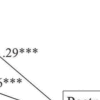Role of Intrapartum Social Support in Preventing Postpartum Depression
- PMID: 37415935
- PMCID: PMC10321456
- DOI: 10.1891/JPE-2022-0003
Role of Intrapartum Social Support in Preventing Postpartum Depression
Abstract
A cross-sectional, multicenter study examined the role of intrapartum social support (SS) on postpartum depression (PPD), using survey data that covered eight of the 25 PPD risk factors identified by a recent umbrella review. A total of 204 women participated at an average of 1.26 months after birth. An existing U.S. Listening to Mothers-II/Postpartum survey questionnaire was translated, culturally adapted, and validated. Multiple linear regression found four statistically significant independent variables. A path analysis determined that prenatal depression, pregnancy and childbirth complications, intrapartum SS from healthcare providers and partners, and postpartum SS from husbands and others were significant predictors of PPD, while intrapartum and postpartum SS were intercorrelated. In conclusion, intrapartum companionship is as important as postpartum SS in preventing PPD.
Keywords: Labor companionship; Obstetric complications; Postpartum depression; Prenatal depression; Social support.
© Copyright 2023 Lamaze International.
Figures
Similar articles
-
Investigating the association between maternal childbirth intention, labor epidural analgesia, and postpartum depression: A prospective cohort study.J Affect Disord. 2023 Mar 1;324:502-510. doi: 10.1016/j.jad.2022.12.108. Epub 2022 Dec 28. J Affect Disord. 2023. PMID: 36586623
-
Sociodemographic and delivery risk factors for developing postpartum depression in a sample of 3233 mothers from the Czech ELSPAC study.BMC Psychiatry. 2017 Mar 21;17(1):104. doi: 10.1186/s12888-017-1261-y. BMC Psychiatry. 2017. PMID: 28327118 Free PMC article.
-
Obstetric anesthesia clinic childbirth course combined with labor epidural analgesia is associated with a decreased risk of postpartum depression : a prospective cohort study.BMC Anesthesiol. 2022 Dec 15;22(1):389. doi: 10.1186/s12871-022-01931-y. BMC Anesthesiol. 2022. PMID: 36522711 Free PMC article.
-
Intrapartum violence during facility-based childbirth and its determinants: A cross-sectional study among postnatal women in Tanzania.Womens Health (Lond). 2023 Jan-Dec;19:17455057231189544. doi: 10.1177/17455057231189544. Womens Health (Lond). 2023. PMID: 37650373 Free PMC article.
-
New parents' experiences of postpartum depression: a systematic review of qualitative evidence.JBI Database System Rev Implement Rep. 2019 Sep;17(9):1731-1769. doi: 10.11124/JBISRIR-2017-003909. JBI Database System Rev Implement Rep. 2019. PMID: 31021977
Cited by
-
COVID-Related Visitor Restrictions and Childbirth Experiences in One US Hospital.J Perinat Neonatal Nurs. 2024 Oct-Dec 01;38(4):403-413. doi: 10.1097/JPN.0000000000000803. Epub 2024 Nov 7. J Perinat Neonatal Nurs. 2024. PMID: 39325945
References
-
- Asefa, A. , Semaan, A. , Delvaux, T. , Huysmans, E. , Galle, A. , Sacks, E. , Bohren, M. A. , Morgan, A. , Sadler, M. , Vedam, S. , & Benova, L . (2021). The impact of COVID-19 on the provision of respectful maternity care: Findings from a global survey of health workers. Women and Birth , 35(4), 378–386. 10.1016/j.wombi.2021.09.003 - DOI - PMC - PubMed
-
- Beck, C. T. , & Gable, R. K . (2002). Postpartum depression screening scale . Western Psychological Services.
LinkOut - more resources
Full Text Sources

